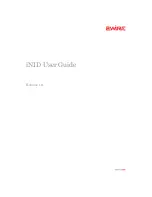
P300H
P300 Series Modem Installation and Operating Handbook
Page 66
6.6.7
Change, Tx, CLOCKING Menu
Paradise Datacom products have always provided a `Data Marginal` warning where the incoming data
phase is monitored with respect to the clock. The Modem shows a `Data Marginal` warning on the front
panel if the data
changes
at the
instant
where it should be stable (and is sampled by the modem) which
would otherwise cause data errors with no fault indication.
On the P300 this is taken a stage further and if the data phase is incorrect with respect to the normal
clock edge, then the modem automatically switches to the other clock edge to sample the data. A Data
Marginal warning is only issued momentarily as the phase switches. If regular Data Marginal warnings
appear (for example in the traffic log) then the Tx data and clock phase are drifting (causing the modem
to switch repeatedly) and you will be getting regular data errors.
This is not a modem fault, it is a
warning of a situation causing data errors of which you would otherwise be unaware !
For this
reason it is not possible to simply disable the Data Marginal alarm, instead you must investigate the
external equipment to find why the Tx clock/data phase is changing.
The Tx clocking menu is as follows:
Tx clock mode: [?]
1=Tx Clock In 2=Internal 3=Rx ref(=Sat)
Change, Tx, Clocking Menu
This selects the clock source used to generate the signal towards the satellite. The options are:
ÌÈ ÝÔÑÝÕ
The external clock supplied on the interface
`Clock In`
line will be used (see
interface card details in appendix A for line names). Should this clock input fail
the Modem will switch to an internal backup clock (as used when
×ÒÌÛÎÒßÔ
is
selected) to maintain the carrier, distant demodulator lock, and if a framing
overhead is active, the Backward Alarm, Aux, and ESC channels.
×ÒÌÛÎÒßÔ
The Modem outputs a clock on the `
Int Tx clock out
` line (see interface card
details in appendix A for line names) for use by the external equipment. Unlike
the previous Paradise products, there is
no requirement
to loop this clock
back into the `
Clock In
` line, on the P300 Modem it is routed internally.
The clock is normally generated from the internal frequency reference of
±
1PPM. However if a Station Clock of 10MHz (only) is applied to the unit, then
under the Rx Clocking screens it is possible to force the modem to replace the
internal 1PPM reference with the 10MHz Station Clock as the reference for
all
clocks and IF synthesizers
which normally use the internal reference. If this is
the case then the
ײ¬»®²¿´ Ý´±½µ
would be generated from the 10MHz station
clock.
ÎÈ ÎÛÚøã
???
÷
As
×ÒÌÛÎÒßÔ
except the Tx clock is generated from the Rx
output
clock.
λºøã
???
÷
shows the current Rx clock setting from which the Rx output clock is
itself being generated.
This option is only of any practical use when the Rx
Clocking is set to
Í¿¬»´´·¬»
or
ͬ¿¬·±² Ý´±½µ
. When the Rx Clocking =
Í¿¬»´´·¬»
this is commonly called
`Loop Timing`
.
Note
: it uses the Rx
output
clock,
not
necessarily
the clock from the
satellite
, ie the clock used depends on the Rx Clocking setting. This means for
example that if the Rx Clocking =
ͬ¿¬·±² Ý´±½µ
, then setting Tx Clocking =
Ψ
®»ºøãͬ²÷
would slave the Tx Clock ultimately from the Station Clock (whatever
















































